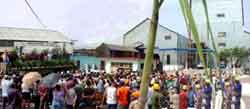Cuba sugar ministry to be shut in reform
- Submitted by: admin
- Business and Economy
- 04 / 09 / 2010

Cuba's sugar ministry will close in the coming months and be replaced by a state-run corporation, business sources said, in the most important reorganisation of the once-thriving industry since it was drastically downsized in 2002.
Plans to create the new sugar corporation and revitalise the industry by, among other things, allowing foreign investment and closing inefficient sugar mills are nearing final approval by President Raul Castro, said the sources, who know the industry well and asked not to be identified.
The ministry's upcoming demise appears to be the last chapter in the dramatic decline of the sugar industry in a Caribbean island country where sugar was once king but now accounts for less than 5% of foreign exchange earnings.
This latest move is similar to other agricultural reforms under Castro, who replaced older brother Fidel Castro in 2008 and is trying to increase food output by loosening the communist-led government's control over farming.
Cuba's fall from once being the world's biggest sugar exporter, producing 8 million tonnes of raw sugar annually, began with the collapse of former benefactor the Soviet Union in 1991.
Since then, the ector has declined relentlessly and output is expected to be only 1.2 million tonnes this harvest.
But with the upcoming reorganisation, "in the medium-term they hope to increase production to 2.8 million tonnes using fewer mills," a Cuban ource with intimate knowledge of the sugar industry said.
"Yields per hectare are currently around 3 tonnes per hectare and the oal is to bring them up to at least 6 tonnes," he added.
The international standard is 8 tonnes per hectare.
Cuba itself consumes a minimum 700,000 tonnes of sugar annually.
More autonomy sought
Similar corporations to the one planned for sugar operate with foreign partners in nickel (Cubaniquel) and oil and gas (Cubapetroleo) under the asic Industry Ministry.
It was not clear if the new sugar sector ompany would fall under the agriculture ministry or some other overnment authority.
"The new structure will give decision makers in the industry more autonomy and allow them to keep a percentage of revenues for e-investment," a Cuban economist said, asking like the others that his name not be used.
The United States, before the 1959 Cuban Revolution, and later the Soviet Union, paid padded prices for Cuban sugar to boost the island's economy, so the subsequent collapse of the Soviet bloc hit Cuba and its ugar industry hard.
Today, technical service exports are Cuba's most important foreign exchange earner, followed by other services such as aviation, tourism nd communications, then nickel, refined oil products, pharmaceuticals,cigars and only then sugar.
In a painful 2002 downsizing of what was once the island's flagship sector, Cuba shut down and dismantled 71 of 156 mills, all 71 built well before the revolution, and relegated 60 percent of sugar plantation land to other uses.
More than 200,000 of the industry's 400,000 workers were moved to other employment and many rural sugar towns were left stagnating, their closed mills marking the skyline.
More mills have closed since then, with just 44 mills open this season.
Another 20 have been maintained in working condition for future use.
Only 700,000 hectares of the more than 2 million hectares once controlled by Cuba's sugar ministry are currently dedicated to sugar cane.
Under Raul Castro, former sugar plantations already have been shifted to the agriculture ministry, and a vast railway system to move cane from the fields and sugar to port has been handed over to the transportation ministry.
http://tvnz.co.nz/business-news/cuba-sugar-ministry-shut-in-reform-3451985
Source: cuba.blogspot.com/
Comments